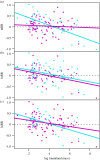Strength of the 'island rule' in birds is positively associated with absence of avian predators
- PMID: 36946130
- PMCID: PMC10031422
- DOI: 10.1098/rsbl.2022.0536
Strength of the 'island rule' in birds is positively associated with absence of avian predators
Erratum in
-
Correction: 'Strength of the "island rule" in birds is positively associated with absence of avian predators' (2023), by Ponti et al.Biol Lett. 2023 Dec;19(12):20230550. doi: 10.1098/rsbl.2023.0550. Epub 2023 Dec 13. Biol Lett. 2023. PMID: 38087943 Free PMC article. No abstract available.
Abstract
The similar characteristics shared by island environments have been shown to lead to common patterns of adaptations in island species, commonly referred to as the 'insularity syndrome'. A well-known example is the 'island rule', where large species become smaller on islands and small species become larger, leading to well-known cases of dwarfism and gigantism. This pattern was recently verified on a global scale, but the mechanisms underlying it have been poorly investigated. Here, we focused on the role of released pressure from predation and competition experienced by island birds. Using 120 pairs of endemic island species and their mainland sister relatives, we first verified that the island rule was detected in our dataset, and then evaluated the effects of the numbers of raptors and interspecific competitors on the evolution of the insular species' body mass. We found a strong effect of predation on body mass evolution, with a stronger island rule for species occurring on islands with no raptors, while the pattern disappears in their presence. However, we did not find an effect of competition on this pattern. Our study shows the importance of considering ecological interactions for understanding patterns of body size evolution, and the exceptions to those patterns.
Keywords: body mass; competitors; ecological release; insularity; raptors.
Conflict of interest statement
We declare we have no competing interests.
Figures


References
-
- Grant PR. 1965. The adaptive significance of some size trends in island birds. Evolution 19, 355. (10.2307/2406446) - DOI
-
- Whittaker RJ, Fernández-Palacios JM. 2007. Island biogeography: ecology, evolution, and conservation. Oxford, UK: Oxford University Press.

